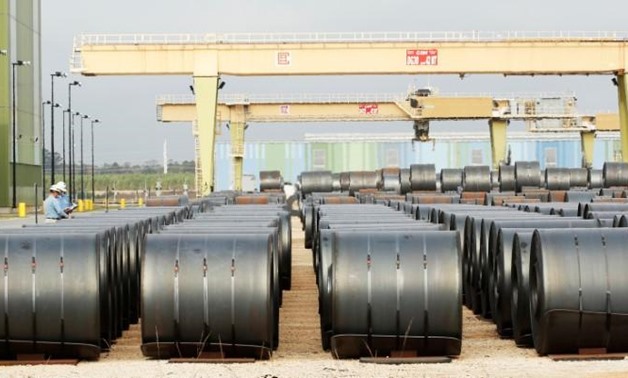
Steel coils at the ThyssenKrupp Steel USA factory are pictured in Calvert, Alabama November 22, 2013. REUTERS/Lyle Ratliff/File Photo
ARLINGTON, Va. - 14 October 2017: The Trump administration is demanding the use of North American-made steel, aluminum, copper and plastic resins in cars and trucks sold under North American Free Trade Agreement rules, as it seeks to give U.S. industry a boost.
People briefed on the matter said U.S. negotiators issued the proposal, which could force automakers to shift sourcing of some components to North America from Asia, during talks on Friday to overhaul NAFTA.
It calls for the inclusion of steel, aluminum and other raw materials on a so-called NAFTA tracing list for auto parts, according to the sources, referring to the mechanism by which the regional content level of cars, trucks and large engines is monitored and verified under the trade agreement.
The list would be greatly expanded under the U.S. proposal to cover a vast and complex web of automotive components, essentially eliminating the concept of "deemed originating," under which parts not listed get a free pass to tariff-free NAFTA access, no matter their origin.
In addition to the metals and plastics, the list would now include sophisticated automotive electronics, electric vehicle batteries and other parts not on the tracing list because they did not exist when NAFTA was negotiated by Canada, Mexico and the United States in the early 1990s.
If Washington prevails, the components would now need to be sourced from North America to count toward proposed sharply higher content levels, or companies would need to pay U.S. tariffs of around 2.5 percent on them.
People briefed on the U.S. proposal said it would lift the regional content threshold to 85 percent from the current 62.5 percent, with a 50 percent minimum U.S. content level.
A spokeswoman for the U.S. Trade Representative's office declined to comment on the auto industry proposal.
U.S. Commerce Secretary Wilbur Ross has vowed to close "loopholes" in the parts list that he says allow too many cheap auto parts from Asia and other regions to enter the United States.
Ross has already sought to protect the U.S. steel and aluminum industries from subsidized imports with national security reviews that could lead to import restrictions.
Steel industry trade groups from all three NAFTA countries in June issued a joint statement calling for any renewal of the trade pact to require North American steel use in manufactured goods.
However, two people briefed on the talks said the U.S. proposal stops short of labor unions' call for "melted and poured" North American steel, which would have precluded the use of raw steel from elsewhere that has been rolled or otherwise processed on the continent.
Automakers in North America largely already use North American steel but currently get no content value credit for it. Adding it to the tracing list would get a typical vehicle hundreds of dollars closer to meeting the goal.
But any such gains would be offset largely by the higher overall content thresholds and the need to find other sources for electronics, said Kristin Dziczek, a trade and labor economist with the Center for Automotive Research in Ann Arbor, Michigan.
Dziczek and auto industry groups say that the U.S. content proposal was likely to backfire, with automakers and suppliers simply choosing to pay the 2.5 percent U.S. tariffs for passenger cars and many parts, sourcing more of them from China or other Asian countries.
"That could be the preferred trading route if NAFTA becomes too strict," she added.


Comments
Leave a Comment